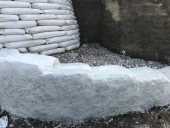posted 14 years ago
Castlerock,
I'm a natural builder, been working with cob and other materials for around 13 years or so..
I've found so far that (as a general rule) portland and cob don't play well together. I've not yet had good results mixing the two or putting them in contact with each other. I've heard from others that dirt-crete can be made to work well, it's NOT been my experience thus far.
Seems to me that concrete is just to hydrophilic, it wants to wick and hold onto moisture and that ain't what cob needs. Anymore, the ONLY place I'll accept concrete (in my buildings) is at the foundation level, even there I get a bit nervous.
Not too long ago, I did a tour of all the old California missions that I could get to. I found that EVERYWHERE they used concrete, portland or stucco to repair or "protect" these old buildings there was a failure of some kind. In fact, it seems to be THE major failure points of these old buildings. It's a shame really, folks have worked hard to keep these historical sites together, doing their best with what they thought would do the job. Now, it seems, the best way to save 'em is to undo all the hard work done to save 'em in the first place. If the stucco is NOT removed from the old adobe missions, their days are numbered.
The British cob builders, in the north of England (where it rains and sleets sideways for a major chunk of the year), have a saying: "With a good hat and a good pair of boots, cob will experience a loss of face at about an inch a century."
Build it yourself, make it small, occupy it.

 7
7




 3
3




 1
1




 1
1




















 2
2












 1
1












 10
10













